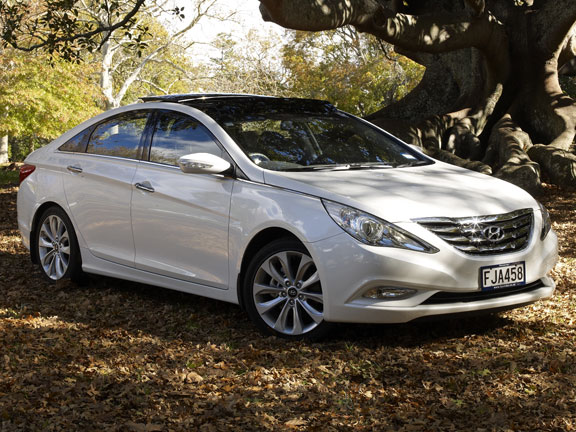
The release of Hyundai’s previous generation Hyundai Sonata back in 2005 – at the time undeniably the best Korean car our market had seen – was surrounded with all that ‘oohh, haven’t Korean cars come a long way’ talk that seemed to get trundled out with every Korean vehicle review since. It was deserving praise then, but let’s put a stop to it now, eh?
The quality evident in Hyundai’s subsequent models is no longer a surprise; it’s expected. That’s a good thing of course, and naturally, the Sonata’s replacement, the i45 continues this theme.
Let’s not all chow down on the Kim-Chi and Bulgogi just yet though, Korean car manufacturers may be looking at high-end European vehicles for influence and benchmarking, but a couple of things do continue to slip under Hyundai’s radar.
But first those European touches, there’s plenty of them here. Our tester was the top spec Elite model (only the best for AutoTrader); the interior is a quantum leap from the Sonata and a step up from anything else in the stable. The leather has a notably more natural, almost Euro feeling (thank God,) and the Elite Limited spec includes a full panoramic glass roof like you can on a Mercedes E-class, the centre stack exhibits a BMW i-Drive-inspired control knob for the audio system, the dual zone climate controls feature cutesy little man-shaped buttons – as per Volvo models – to select the directional mode of air flow onto the different bits on your cutesy man-shaped body. Orrh.
Borrowing the best of Europe’s innovations all works well in the i45, it’s an easily navigated layout and the classy touches of trendy ‘Piano Black’ plastics mixed in with adequately soft touch dash treatments keep things inside this $48,990 sedan looking the part.
All the vital statistics for executive travel are covered too, six-airbags are standard as is electronic stability control and full iPod integration, but the Elite adds handy keyless start, dual-zone climate air with an in-built purifier, rain sensing wipers reversing sensors, electric memory front seating adjustments – and wow, plush! – front and rear heated seats.
The styling is a combined effort between Hyundai’s North American, Russelsheim and Korean design studio, which at the end of the day is an expensive attempt to guarantee appeal in the brand’s three key markets. The result though is an equally confusing mish-mash, with parts of the car not really complementing others that well ,and too many unnecessary body creases. It all seems over designed to my eyes. Maybe someone should tell Hyundai too many cook spoil the broth? I nominate Peter Schreyer, the ex Audi designer who has given Hyundai’s sister company, Kia, a more recognisable and global-friendly styling direction.
Drivers will find it harder to live with the typically Korean handling dynamics, even with the Elite version’s promise of “sporty” suspension tuning. The i45 exhibits fantastic noise, vibration and harness suppression which is important in their domestic market, but it’s a shame the traits of a well-engineered European chassis haven’t been accurately replicated. There’s no competition for the Suzuki Kizashi or Mazda6 in terms of driver engagement with the front end reluctant to react to driver’s input under steer is an unsatisfying side effect. More mechanical grip from the 205/65 R18 tyres would also improve the car’s confidence on slippery volcanic chip Kiwi roads.
FYI – Hyundai New Zealand have hinted that the rear-drive, Genesis luxury sedan will be here within a year. Fingers-crossed this will make right the errs of Hyundai’s front drive chassis thus far…but that’s a story for another time.
For those of you that aren’t so fussed about handling agility – and I appreciate you probably outnumber us enthusiast drivers – you will actually enjoy your time behind the wheel of an i45. Certainly the Elite’s 2.4-litre engine is the best out of Korea yet. More or less, it’s the same ol’ ‘world engine’ that’s wheezed inadequately under the bonnet of Hyundai, Kia, Mitsubishi and Chrysler product over the last few years thanks to a joint venture between the brands.
However, direct injection now breathes new life. Matched with an excellent six-speed transmission it’s the real surprise of the i45 and has me excited for upcoming versions that will filter down to other Hyundai’s shortly.
The direct injection has greatly improved economy (claimed 7.9 litres/100km), power and torque – not just on paper with a potent 148kW @ 6300rpm and 250Nm @ 4250rpm on offer, but also in real-world delivery. The torque curve is notably flatter and performance muscular and often entertains even with minimal throttle and across a broad rev range.
Hyundai have avoided the trend toward CVT transmissions and the driving experience is far better for it, the transmission shift protocols focus more of smoothness than performance but you can still have a good time flipping through actual ratios – not the unconvincing simulated CVT gearing – via the wheel-mounted flappy paddles. I rate the drivetrain over and above almost all of the comparable Japanese equivalents and save for some refinement and a minimal power-per-capacity deficit, the engine isn’t a great way off the Volkswagen Group’s brilliant FSI four cylinder power units. One for the record books.
The Quality we all made a song and dance about in 2005 has been updated accordingly, and while the drive won’t silence every critic, it makes a stronger case for itself than any previous Hyundai sedan. Gee, haven’t they come a long way?…Oops.
See the Hyundai i45 for sale.